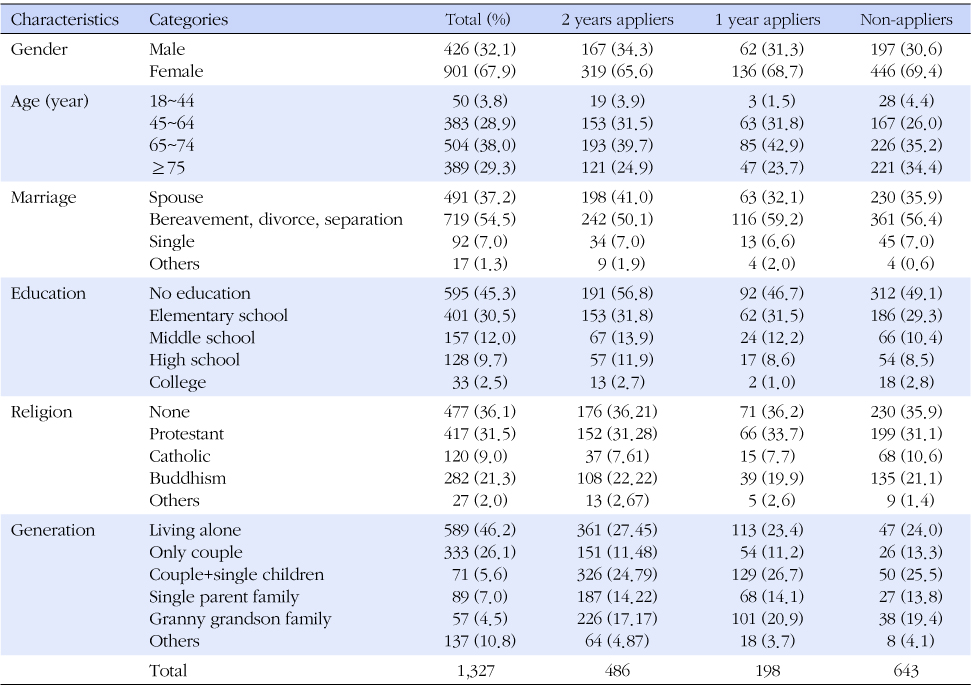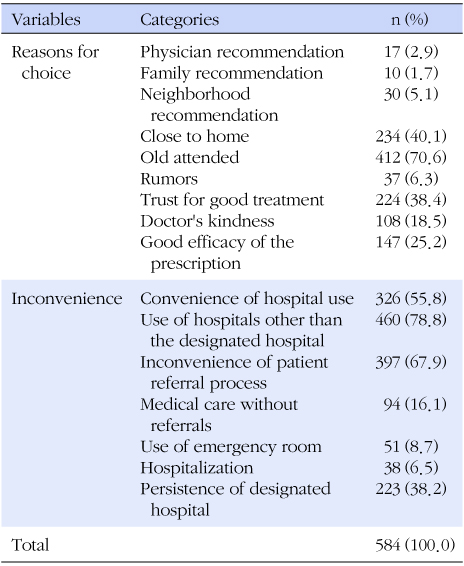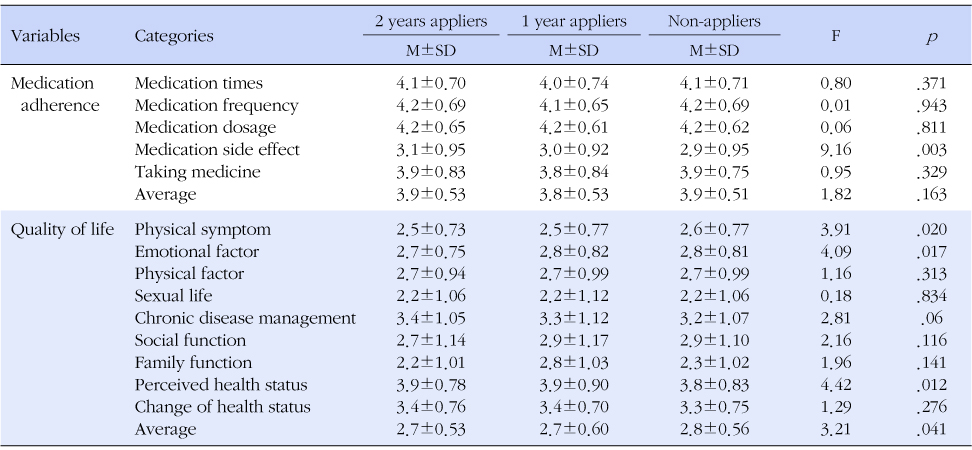Articles
- Page Path
- HOME > J Korean Acad Community Health Nurs > Volume 23(4); 2012 > Article
-
Original Article
- The Effects of the Designated Doctor System on the Health of Medical Aid Beneficiaries
- Jeongmyung Choi, Jinjoo Oh
-
Journal of Korean Academy of Community Health Nursing 2012;23(4):438-445.
DOI: https://doi.org/10.12799/jkachn.2012.23.4.438
Published online: December 31, 2012
1Department of Nursing, Suwon Science College, Hwaseong, Korea.
2Department of Nursing, Dankook University, Cheonan, Korea.
• Received: November 12, 2012 • Accepted: December 22, 2012
Copyright © 2012 Korean Academy of Community Health Nursing
- 471 Views
- 0 Download
- 3 Crossref
Abstract
-
Purpose
- Medical Aid Beneficiaries were surveyed to identify differences in health behaviors, adherence to drug regimen, and quality of life between those people in the Designated Doctor System and those who are not.
-
Methods
- A total of 1,327 study subjects were separated into three groups: those in the Designated Doctor System for 2 years, those in for 1 year, and those not in the system.
-
Results
- After the introduction of the Designated Doctor System, 55.8% and 67.9%, respectively, of the subjects in the Designated Doctor System complained of inconvenience in relation to hospital use and the patient referral process. Also, the rate of emergency room use or hospitalization guided by the Designated Doctor System was only 8.7% and 6.5%, respectively. There were no significant differences in health behaviors and adherence to drug regimens between those in the Designated Doctor System and those who are not.
-
Conclusion
- This study was carried out early in the introduction of the system. Therefore, it is necessary to monitor the positive and negative effects of the Designated Doctor System for a full reflection of its impact.
- 1. Case Management Society of America. Jun KJ, So AY, Kim HG, Kim CW, Kim YM, translator. Case management adherence guidelines 2.0 2007;Seoul: Hyunmoonsa; (original work published 2007).
- 2. Helms LJ, Newhouse JP, Phelps CE. Copayments and demand for medical care: The California Medicaid experience. Bell J Econ 1978;9(1):192–209.
- 3. Huh BY, Kim CH, Park TJ, Lee KY, Cho B, Kim HJ. Development and evaluation of home doctor registration program. J Korean Acad Fam Med 1998;19(10):801–810.
- 4. Kang EJ, Choi EJ. 2005 The third Korea national health and nutrition examinations survey: Health behaviors of adults 2006;Seoul: Korean Institute for Health and Social Affairs.
- 5. Kephart G, Skedgel C, Sketris I, Grootendorst P, Hoar J. Effect of copayments on drug use in the presence of annual payment limits. Am J Manag Care 2007;13(6):328–334.
- 6. Kim ES, Kim MY, Ko IS, Lee DM, Kim KS, Choi JS, et al. The current situation of medical Aid utilization and improvement direction in long-term utilizers 2007;Seoul: Ministry for Health, Welfare and Family Affairs.
- 7. Kim JY, Ko SK, Yang BM. The effects of patient cost sharing on ambulatory utilization in South Korea. Health Policy 2005;72(3):293–300.
- 8. Lee DM. The need and model program for private doctor. J Korean Acad Fam Med 1996;17(3):194–197.
- 9. Lee YJ. A study of the factors and the regional difference of medical aid program recipient's medical utilization. Soc Welf Policy 2007;28:233–251.
- 10. Lim SJ. The effects of case management for medicaid on healthcare utilization by the medicaid system. J Korean Acad Community Health Nurs 2010;21(4):375–385.
- 11. Ministry for Health, Welfare, & Family Affairs. 2008 Guideline of medicaid management 2008;Seoul: Author.
- 12. Ministry of Health & Welfare. 2007 Guideline of medicaid management 2007;Seoul: Author.
- 13. Ministry of Health & Welfare. 2011 Guideline of medicaid management 2011;Seoul: Author.
- 14. Morsky DE, Levine DM, Greene LW, Shapiro S, Russell RP, Smith CR. Five-year blood pressure control and mortality following health education for hypertensive patients. Am J Public Health 1983;73:153–162.
- 15. Shin HU, Shin YS, Hwang DK, Yoo YS, Choi GC, Lim SJ. Monitoring the designated doctor system 2008-b;Seoul: Korea Institute for Health and Social.
- 16. Shin SM, Kim ES, Lee HW. The contributing factors to surplus medicine by long-term users of medical aid in Korea. J Prev Med Public Health 2009;42(6):403–407.
- 17. Shin YA, Shin HC, Shin HW, Park EJ, Hong SW, Shin SM, et al. Health services use and health status of medicaid beneficiaries according to medicaid policy change 2008-a;Seoul: Ministry of Health, Welfare and Family Affairs, Korea Human Resource Development Institute for Health and Welfare, & Institute of Case Management for Medicaid.
- 18. Shin YE, Shin HC, Shin HW, Park EJ, Hong SW, Shin SM, et al. Study on the health status and hospital service utilization of Korea medicaid clients 2007;Seoul: Korea Human Resource Development Institute for Health and Welfare.
- 19. Shin YJ, Yu YS, Choi YE, Shin SJ, Kim SJ, Uoo KS. Monitoring for medicaid financial efficiency and Improvement Direction 2006;Seoul: Ministry of Health & Welfare.
- 20. Shin YS, Choi BH, Shin HU, Hwang DK, Eun SJ. The research regarding the healthcare expenditure and medical treatment material service use actual condition and a improvement program 2005;Seoul: Ministry of Health & Welfare. Korean Institute for Health and Social Affairs.
- 21. Trivedi AN, Rakowski W, Ayanian JZ. Effect of cost sharing on screening mammography in medicare health plans. N Engl J Med 2008;358:375–383.
- 22. Tamblyn R, Laprise R, Hanley JA, Abrahamowicz M, Scott S, Mayo N, et al. Adverse events associated with prescription drug cost-sharing among poor and elderly persons. JAMA 2001;285(4):421–429.
Figure & Data
References
Citations
Citations to this article as recorded by 

- The Effect of Case Management Services for High-risk Medicaid Beneficiaries
Young Jin Ahn, Yun-Kyoung Choi
Journal of the Korea Academia-Industrial cooperation Society.2015; 16(8): 5430. CrossRef - The Effects of the Designated Doctor System on Health Care Utilization of Medical Aid Beneficiaries with Chronic Diseases
Min Jung Kim, Young-Ha Cho, Nam Hee Park
Journal of Korean Academy of Community Health Nursing.2015; 26(3): 278. CrossRef - A Study on Influential Factors on Satisfaction with the Use of Medical Services by the Qualified Recipients of Medical Aid(focusing on the period after the introduction of the selected medical center system)
Jin-Woo Lee, Se-I Yang, Kwang-Hwan Kim
Journal of Digital Convergence.2014; 12(3): 289. CrossRef

 KACHN
KACHN





 PubReader
PubReader Cite
Cite

